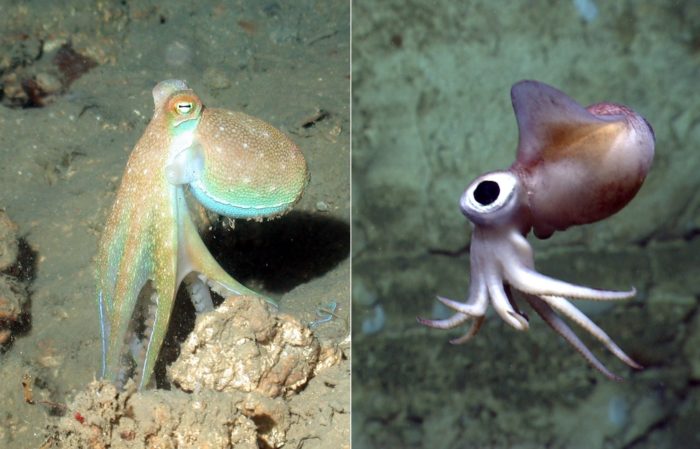
What’s the Difference? Octopus vs. Squid

Photo credits: Octopus – NURC/UNCW and NOAA/FGBNMS. Squid – NOAA OKEANOS Explorer Program 2013 Northeast U. S. Canyons Expedition.
You wouldn’t be alone if you thought the octopus and squid were the same animals. They are cousins—both part of the group cephalopoda—a group of marine mollusks that include squid, octopus, nautilus, and snails. These animals are all characterized by symmetrical bodies, no vertebrae, prominent heads, and arms or tentacles that extend from their bodies. Unlike nautilus and snails, the octopus and squid evolved to have bodies that don’t require use of a hard shell for protection, which is due to other adaptations that they developed like the ability to camouflage, heightened intelligence, and strong, flexible arms.
There are nearly 300 species of squids and 300 species of octopus in the global ocean. So, what are the differences between the two?
Where they live: Squids generally live in the open ocean while octopuses call the seafloor home, usually in dark crevices; both live in saltwater from the tropics to more temperate zones.
What they eat: Octopuses usually eat crustaceans from the ocean floor while squids usually feed on shrimp and small fish in the water column.
How they eat: Octopuses grab their prey with their arms, pierce through their shells or skin to inject paralyzing venom, and crushes the body in their mouth. Squids use their two long tentacles to catch prey and eat it in chunks.
How they look: Octopuses have a mantle, rounded head, rectangular pupils on their two eyes, eight arms, and come in a wide variety of colors while squids have two fins at the top of their mantle, a triangular head, circular pupils on their eyes, a rigid backbone-like structure called a pen, and a combination of arms and tentacles, which have hooks and suckers.
Their appendages: Octopuses have eight arms covered in suckers while squids have eight arms and two longer tentacles used to catch fish and shrimp in open-ocean waters. Octopus arms are more flexible than those of a squid, allowing them to walk, handle objects, and manipulate their environment.
Defenses: Some species of squids can expel clouds of ink into the water for a quick escape when they feel threatened while an octopus can change colors to hide or squeeze their bodies into the tiniest of crevices or objects like shells.
Reproduction: Male octopuses use a specialized arm (the hectocotylus) to transfer sperm to a female, who then lays groups of eggs in strings that might resemble decorative strings of holiday lights in her den. Females will guard the eggs until they hatch, which can be anywhere from 30 days to one year later depending on the species. Squids on the other hand mate in large groups, attaching their eggs to fixed structures like rocks or coral. Squid parents don’t invest in their young, they just let them hatch and try to make it in the world.
Lifespan: Octopuses are generally shorter lived with a lifespan of one to three years, while squids can live nine months to five years. Male octopuses and squids usually die shortly after mating.
Social structures: Octopuses are solitary animals (except for mating periods) while squids can live independently or in schools.
